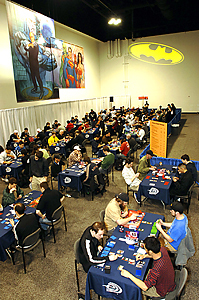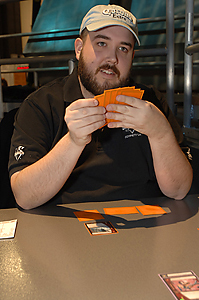
The period immediately after a Pro Circuit is a very exciting one for players. There’s a whole new Constructed format for Pro Circuit Qualifiers, and more importantly, a mountain of information to work with.
 Preparing for a Pro Circuit can be a rather daunting prospect. Everyone keeps their cards to themselves. While some decks and pieces of tech might seem self evident, ultimately any assumptions that players make about the metagame are just that—assumptions. It isn’t until the event itself that everything shakes down. At this point, players get to see how their worldview compares with reality.
Preparing for a Pro Circuit can be a rather daunting prospect. Everyone keeps their cards to themselves. While some decks and pieces of tech might seem self evident, ultimately any assumptions that players make about the metagame are just that—assumptions. It isn’t until the event itself that everything shakes down. At this point, players get to see how their worldview compares with reality.
Now, however, for any player looking to get ready for a Marvel Modern Age event, there are huge amounts of information to work with. If you check out the Metagame Pro Circuit coverage, you will find over 330 decklists. Each of these represents the opinion of one person of what the best deck is to play. The collective hours of testing that have gone into these decklists are frankly dizzying to think about. Sure, some of these decks may not have been the strongest they could be, but there are things to be learned from each.
Even better than having all these decklists (typed up and ready to go by the afternoon of the finals of the Pro Circuit, no less!), we have records of how each and every one of these decks performed, and if one wants to go through and work it out, it is possible to see how different deck archetypes performed in different matchups. That is a lot of information to work with.
For anyone looking to do well in coming PCs, all the tools are there. This is a time for experimentation. Get together a few friends and work on a gauntlet. A gauntlet is a collection of all the different viable decks in the format, and any deck you intend to play should have a reasonable plan against your gauntlet. Start bashing some rocks together and see which one cracks.
 If you are a Squadron Supreme player, you have a few options at your disposal. Even looking at just the final match, there were stark differences between builds. What was the reasoning behind them? How do they change the decks’ performances in various matchups? Shane Wiggans’s build, at first glance, would appear to be better optimized against other beatdown decks, where having Genis-Vell ◊ Photon, Transformed can effectively allow the deck to steal the initiative. Vidi Wijaya’s (and FTN’s) build creates a strange kind of aggression and consistency by packing Enemy of My Enemy and a variety of characters able to burn through controlling decks. The finals didn’t appear to play out that way, but ultimately, I wouldn’t say that it was the fairest of representations of the matchup, because Shane had some truly wretched draws in three straight games.
If you are a Squadron Supreme player, you have a few options at your disposal. Even looking at just the final match, there were stark differences between builds. What was the reasoning behind them? How do they change the decks’ performances in various matchups? Shane Wiggans’s build, at first glance, would appear to be better optimized against other beatdown decks, where having Genis-Vell ◊ Photon, Transformed can effectively allow the deck to steal the initiative. Vidi Wijaya’s (and FTN’s) build creates a strange kind of aggression and consistency by packing Enemy of My Enemy and a variety of characters able to burn through controlling decks. The finals didn’t appear to play out that way, but ultimately, I wouldn’t say that it was the fairest of representations of the matchup, because Shane had some truly wretched draws in three straight games.
With the X-Faces deck, there were a few variations on the theme of powerful low-drop characters and ongoing plot twists. For Atlanta, I am of the opinion that the Donkey Club build, which sported a full complement of Mob Mentality and a Brave New World to get it online, was the optimal build, though there is enough room for singleton answers to problem cards in the format that it may well not stay that way. If Avengers, with its Hawkeye, Clinton Barton and its Wonder Man, is on the down swing, then it is quite possible that these double-duty pumps should be swapped for something better suited to the adapting metagame. The deck is, in my experience, pretty absurdly consistent, but it is also pretty tricky to play. Every turn there are a lot of decisions to be made, some of which won’t be acted upon for a few turns. While strictly speaking there are a lot of ways to fetch Faces of Evil from the deck, it has various other Team-Ups that are pretty important to find. I very much doubt that we have heard the last of X-Faces. It didn’t perform overwhelmingly in the Top 8, but it did scoop many of the top Swiss finishes for the event. I’m sure that Mr. Anand Khare will have more to say on this deck than I ever could.
 My personal favorite deck from the weekend was the Mental control deck. I should just point out now that I’m not convinced it’s the most powerful option for Marvel Modern Age, but it does seem like a blast to play. Nothing fills me with childlike glee more than making the best laid plans of opponents worthless in the face of nifty defensive tricks. The biggest issue for the deck appeared to be that if it missed early drops, it could simply not recover from a fast Squadron or Faces start—clearly not a good thing. Bearing this in mind, my favorite build is probably the one we saw in the hands of Matt Oldaker in the Top 8.
My personal favorite deck from the weekend was the Mental control deck. I should just point out now that I’m not convinced it’s the most powerful option for Marvel Modern Age, but it does seem like a blast to play. Nothing fills me with childlike glee more than making the best laid plans of opponents worthless in the face of nifty defensive tricks. The biggest issue for the deck appeared to be that if it missed early drops, it could simply not recover from a fast Squadron or Faces start—clearly not a good thing. Bearing this in mind, my favorite build is probably the one we saw in the hands of Matt Oldaker in the Top 8.
System Failure is something of a narrow choice for the format as it stands. While very good against Faces of Evil, it is often a virtually dead card in most other matchups; while there are a lot of ATK pumps floating around, they are being played on characters with surprisingly high printed ATK values a fair amount of the time. The use of Eye of the Storm, Beast, Feline Geneticist, and Acolyte Body Armor to stave off the early beats seems sound, and having access to Worthington Industries, X-Corp, Tarot, and Sage, Tessa makes this build the most consistent for my money. Whether it can hold off more burn-oriented attacks is something that I for one will be testing carefully.
Speaking of burn, we have my final pick for MMA, Jesse Hill’s innovative Energy burn deck. I’ve always been a fan of finding ways to eschew the combat step for damage where possible, and it seems that there is a critical mass of burn in the format that allows for it to work. This was a deck that came more or less out of the blue as far as my testing prior to the event was concerned, but it is something that I am thoroughly looking forward to learning more about in the coming weeks and months. Was it a great call for an individual event, or is it something that can compete going forward? Only time will tell.
Clearly, there were more decent archetypes in the field than just these four; Niles Rowland’s Hellfire Club control and some version of a reservist build are definitely worth testing. The format has panned out to be a big battle between very controlling and very aggressive strategies, and, as seen with the reservist build, some decks have rather gotten lost in the middle. It will be interesting to see whether or not the innovative deckbuilder can take the lists provided from some of the best in the game and make them even better.
As jet lag from Atlanta catches up with me, I feel I have to close here. Tune in next week for the results of the Willoughby Team Classic and some thoughts on Golden Age and team play.
Have fun and be lucky!
Tim “Got No Sleep on the Flight Home . . . Jebaileyed” Willoughby
timwilloughby@hotmail.com